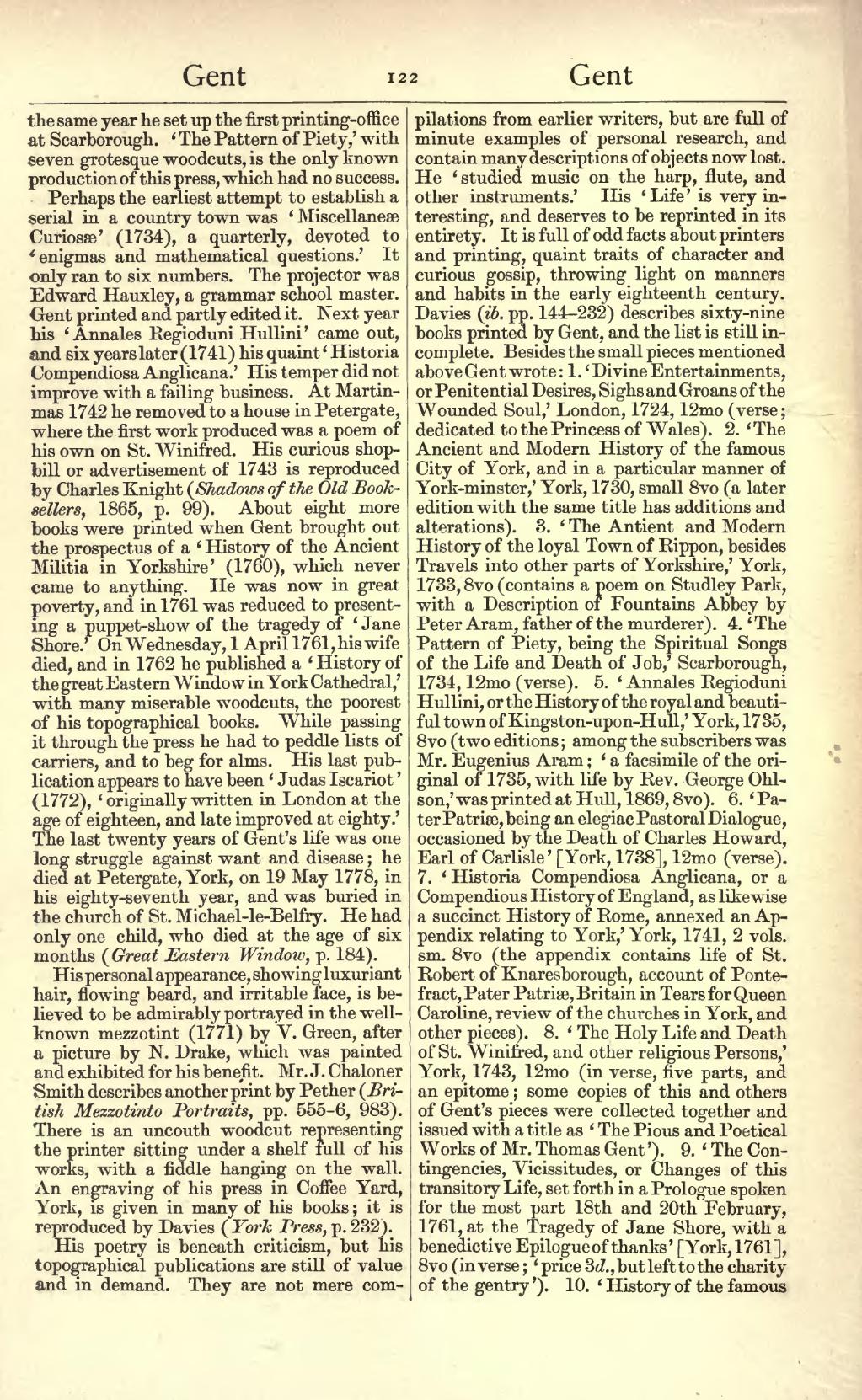the same year he set up the first printing-office at Scarborough. ‘The Pattern of Piety,’ with seven grotesque woodcuts, is the only known production of this press, which had no success.
Perhaps the earliest attempt to establish a serial in a country town was ‘Miscellaneæ Curiosæ’ (1734), a quarterly, devoted to ‘enigmas and mathematical questions.’ It only ran to six numbers. The projector was Edward Hauxley, a grammar school master. Gent printed and partly edited it. Next year his ‘Annales Regioduni Hullini’ came out, and six years later (1741) his quaint ‘Historia Compendiosa Anglicana.’ His temper did not improve with a failing business. At Martinmas 1742 he removed to a house in Petergate, where the first work produced was a poem of his own on St. Winifred. His curious shop-bill or advertisement of 1743 is reproduced by Charles Knight (Shadows of the Old Booksellers, 1865, p. 99). About eight more books were printed when Gent brought out the prospectus of a ‘History of the Ancient Militia in Yorkshire’ (1760), which never came to anything. He was now in great poverty, and in 1761 was reduced to presenting a puppet-show of the tragedy of ‘Jane Shore.’ On Wednesday, 1 April 1761, his wife died, and in 1762 he published a ‘History of the great Eastern Window in York Cathedral,’ with many miserable woodcuts, the poorest of his topographical books. While passing it through the press he had to peddle lists of carriers, and to beg for alms. His last publication appears to have been ‘Judas Iscariot’ (1772), ‘originally written in London at the age of eighteen, and late improved at eighty.’ The last twenty years of Gent's life was one long struggle against want and disease; he died at Petergate, York, on 19 May 1778, in his eighty-sixth year, and was buried in the church of St. Michael-le-Belfry. He had only one child, who died at the age of six months (Great Eastern Window, p. 184).
His personal appearance, showing luxuriant hair, flowing beard, and irritable face, is believed to be admirably portrayed in the well-known mezzotint (1771) by V. Green, after a picture by N. Drake, which was painted and exhibited for his benefit. Mr. J. Chaloner Smith describes another print by Pether (British Mezzotinto Portraits, pp. 555–6, 983). There is an uncouth woodcut representing the printer sitting under a shelf full of his works, with a fiddle hanging on the wall. An engraving of his press in Coffee Yard, York, is given in many of his books; it is reproduced by Davies (York Press, p. 232).
His poetry is beneath criticism, but his topographical publications are still of value and in demand. They are not mere compilations from earlier writers, but are full of minute examples of personal research, and contain many descriptions of objects now lost. He ‘studied music on the harp, flute, and other instruments.’ His ‘Life’ is very interesting, and deserves to be reprinted in its entirety. It is full of odd facts about printers and printing, quaint traits of character and curious gossip, throwing light on manners and habits in the early eighteenth century. Davies (ib. pp. 144–232) describes sixty-nine books printed by Gent, and the list is still incomplete. Besides the small pieces mentioned above Gent wrote: 1. ‘Divine Entertainments, or Penitential Desires, Sighs and Groans of the Wounded Soul,’ London, 1724, 12mo (verse; dedicated to the Princess of Wales). 2. ‘The Ancient and Modern History of the famous City of York, and in a particular manner of York-minster,’ York, 1730, small 8vo (a later edition with the same title has additions and alterations). 3. ‘The Antient and Modern History of the loyal Town of Rippon, besides Travels into other parts of Yorkshire,’ York, 1733, 8vo (contains a poem on Studley Park, with a Description of Fountains Abbey by Peter Aram, father of the murderer). 4. ‘The Pattern of Piety, being the Spiritual Songs of the Life and Death of Job,’ Scarborough, 1734, 12mo (verse). 5. ‘Annales Regioduni Hullini, or the History of the royal and beautiful town of Kingston-upon-Hull,’ York, 1735, 8vo (two editions; among the subscribers was Mr. Eugenius Aram; ‘a facsimile of the original of 1735, with life by Rev. George Ohlson,’ was printed at Hull, 1869, 8vo). 6. ‘Pater Patriæ, being an elegiac Pastoral Dialogue, occasioned by the Death of Charles Howard, Earl of Carlisle’ [York, 1738], 12mo (verse). 7. ‘Historia Compendiosa Anglicana, or a Compendious History of England, as likewise a succinct History of Rome, annexed an Appendix relating to York,’ York, 1741, 2 vols. sm. 8vo (the appendix contains life of St. Robert of Knaresborough, account of Pontefract, Pater Patriæ, Britain in Tears for Queen Caroline, review of the churches in York, and other pieces). 8. ‘The Holy Life and Death of St. Winifred, and other religious Persons,’ York, 1743, 12mo (in verse, five parts, and an epitome; some copies of this and others of Gent's pieces were collected together and issued with a title as ‘The Pious and Poetical Works of Mr. Thomas Gent’). 9. ‘The Contingencies, Vicissitudes, or Changes of this transitory Life, set forth in a Prologue spoken for the most part 18th and 20th February, 1761, at the Tragedy of Jane Shore, with a benedictive Epilogue of thanks’ [York, 1761], 8vo (in verse; ‘price 3d., but left to the charity of the gentry’). 10. ‘History of the famous
